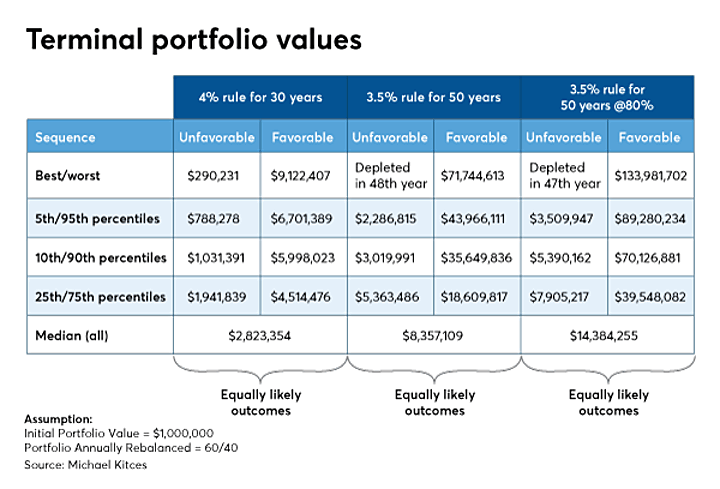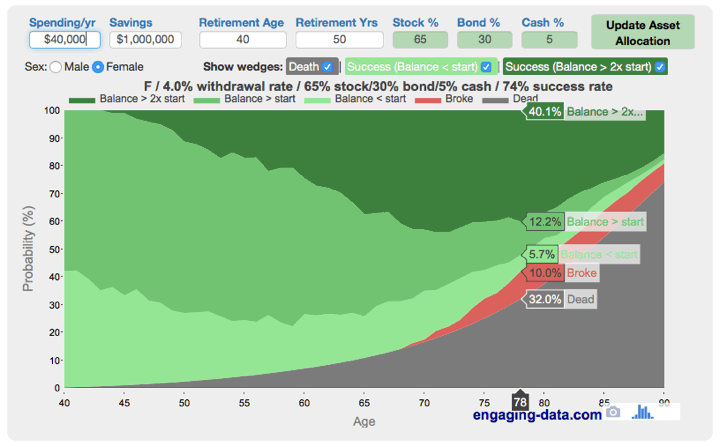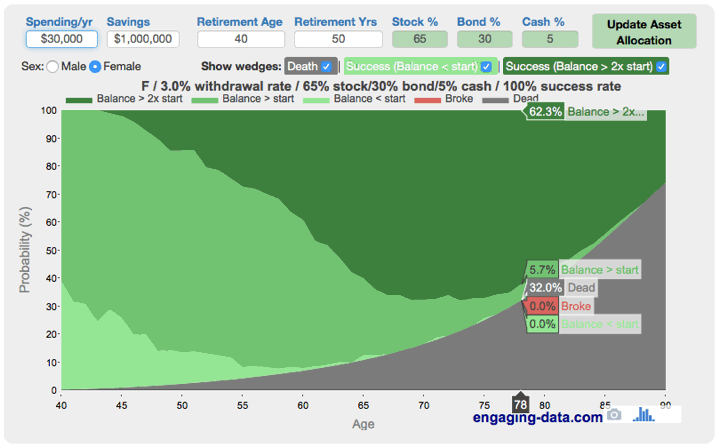When it comes to Financial Independence Retire Early (FIRE), many people get turned off because they define retirement as “never, ever working again for money”. Financial independence fits better with my goal of spending the most of your limited time on Earth aligned with your values.
If the idea is to maximize your independent time, then you have to accept that luck matters. This chart from Michael Kitces explores equally likely scenarios from someone spending down a $1,000,000 portfolio of 60% stocks and 40% bonds.

Equally likely:
- Ending up broke or feel alarmingly like you are headed towards broke.
- Ending up with many, many times more money than you started with.
Is retiring as soon as you reach the 4% rule too risky because you might run out of money? Or is working longer for 3% too risky because you might have wasted years of your life working when you didn’t need to?
Let’s look again at some charts from Engaging Data. Here are sample results for the early retirement scenario at 4% withdrawal rate at age 40 ($40k from a $1m 65/35/5 portfolio, retirement horizon 50 years, female longevity table).

- Red – Alive, but ran out of money.
- Light green – Alive, with less money than you started with.
- Green – Alive, with between 100% and 200% of what you started with.
- Dark green – Alive, with over 200% of what you started with.
- Grey – Dead.
Here is retired at 40 with a lower 3% withdrawal rate ($30k from a $1m 65/35/5 portfolio, retirement horizon 50 years, female longevity table):

Notice at even with the riskier 4% withdrawal rate, you have roughly a 60% chance that your portfolio never goes below the starting balance for as long as you are alive. That means you just spend your 4% every year and it just replenishes itself over and over. Sure, the 3% chart looks safer as there is no red “failure” area. But is that chance of failure worth working maybe another 10 years to go from 25x expenses (4%) to 33x expenses (3%)?
If your portfolio value drops early in retirement, flexible withdrawals are one important tool to improve your portfolio survival odds. However, what about flexible income as well?
What if you retired earlier so that if things go well, you get more retirement years, but if things go bad, then you fall back on some part-time back-up work? Your main risk is of poor returns in the first 10 years of retirement or so. You would accept the chance that you might have to do a little work again to prop your portfolio up during that time. A good part-time job would have the following characteristics:
- Scales up and down easily. Ideally, you could spend 10 hours a week, 20 hours a week, or 40 hours a week on it as necessary. This could mean hourly shift work or flexible self-employment.
- Higher-paid skilled work that is at least partially satisfying. Unskilled work will be the easiest to obtain, but the pay will be low. Uber/Lyft driver, food delivery, home health aide, retail, warehouse, etc. You want something where your special skills are compensated accordingly.
- Minimal maintenance. For some jobs, if you aren’t constantly putting in hours, you’ll become obsolete and won’t be able to start back up again. There may be professional licenses to maintain, etc.
Here’s a brief list of ideas:
- Healthcare. Many positions in the healthcare field can be part-time and hourly, from doctor to nurses to technician positions.
- Elder care. This may be related to healthcare, but the overall aging population is another trend to consider.
- Accounting. An accountant or someone with similar skills can usually find work during tax season, assisting other accountants.
- Tech. There is often consulting or project work available, if you keep your contacts and skills up-to-date.
- Passion work. Turn your hobbies into work. You could be a travel guide, taking people on hikes, tours, kayaking, etc. Carpentry projects could turn into an Etsy store. If you like to fix things, become the neighborhood handyperson.
- Real estate. I tend to break up residential real estate investing into two parts – the actual ownership and the property management. Property management is basically a part-time job which you can do yourself, and the effective wage can be quite high if you are skilled at managing tenants. (The catch is that you can also lose money if you are unskilled at it.)
- Teaching and kid-related. People are having fewer kids, but spending more on each one. Sleep training consultant. Potty training consultant. Academic tutoring at any age. Sports coaching at any age. Chess coaching. Language coaching. Musical coaching. These all command premium hourly rates.
I am a conservative person at heart, and I know that I would worry about my family’s finances if my portfolio dropped significantly from my retirement date. Therefore, I am both using a conservative withdrawal method and maintaining a semi-retired work schedule for the time being. I don’t have the luxury of a full traditional retirement, but I like the balance so far.
Bottom line. Living off of an investment portfolio of stocks and bonds depends a lot on luck. One way to deal with this is to be flexible with your withdrawals. Good luck means spending more, bad luck means spending less. This flexibility may allow you to retire earlier with a smaller portfolio balance. However, you could also plan for a little work income to offset early bad luck with portfolio returns. If you instead have early good luck with market returns, then you’ve just won many more years of free time.
 The Best Credit Card Bonus Offers – 2025
The Best Credit Card Bonus Offers – 2025 Big List of Free Stocks from Brokerage Apps
Big List of Free Stocks from Brokerage Apps Best Interest Rates on Cash - 2025
Best Interest Rates on Cash - 2025 Free Credit Scores x 3 + Free Credit Monitoring
Free Credit Scores x 3 + Free Credit Monitoring Best No Fee 0% APR Balance Transfer Offers
Best No Fee 0% APR Balance Transfer Offers Little-Known Cellular Data Plans That Can Save Big Money
Little-Known Cellular Data Plans That Can Save Big Money How To Haggle Your Cable or Direct TV Bill
How To Haggle Your Cable or Direct TV Bill Big List of Free Consumer Data Reports (Credit, Rent, Work)
Big List of Free Consumer Data Reports (Credit, Rent, Work)
If you are in need of distraction all these 4% rules and calculators might satisfy your curiosity. But as someone who is retired and over 65 I can tell you firsthand they are totally irrelevant.
In a world of $16 trillion of negatively yielding debt and a race to the bottom by every Central Bank in the world nothing can be taken for granted, anticipated or forecasted anymore.
I can also tell you that if you are still lucky enough to receive any Social Security, that the average monthly check minus your Medicare plus the income from $1 million in investments will barely get you by unless lower middle class (if that) is your retirement goal.
On the other hand and its something Jonathan hasn’t explored in depth on the site, living in Asia or South America is the best option for maintaining a normal middle class lifestyle after retirement. You can be economically viable, still be able to save money, maintain some modicum of personal dignity and increase the level of personal security. All with excellent and affordable healthcare. So….be distracted or be smart.
I think becoming an expat is a great idea. However, it’s simply not for everyone. We still are part of communities and many people have family and friends that keep them still rooted (which, has many huge gains including inter-generational relationships and mentorship of young folks). It’s also the idea why Florida probably sounds appealing b/c at least you can go back and see the grandkids for part of the year. Or, they can come visit you while you gain residency in a low-tax state.
Keep in mind that cheaper locales tend to have much higher inflation. I personally wouldn’t bet on those locations remaining cheap for the duration of my retirement…
The Engaging Data “Rich, Dead, or Broke” calculator was a tremendous wake up call for me. I’m a numbers and data guy. Seeing how the chances are you’ll be dead before you can spend the money made me completely rethink my FI savings strategy.
We dropped from saving 50% of my income to 40%. That extra 10% really feels extravagant and we’ll still reach FI quickly.
I encourage everyone to evaluate what’s important in life and spend extravagantly on it. Especially if you are a naturally frugal saver like we are.
For us, dialing back our savings rate by 10% opened up more opportunities to see overseas family and to travel with friends more. Life is just too short to wait until FI to start living.
Interesting Article… thanks Jonathan
Excellent post! Thanks. Lots to think about. I’m close to FI, but still trying to figure out how much savings I need. There is a lot of flexibility on the spending side. I like this quote from Joe Dominguez; Paraphrasing:
Don’t worry too much about inflation because your consciousness grows faster than inflation.
https://yourmoneyoryourlife.com/book/chapter-9-from-1992-edition/
The “Dead” section on the engaging data website along with the 5 regrets of dying which I reviewed on my site made my decision to call it quits easier.
Spencer,
Very nice response and I’ll try to add. One of the keys to doing the important things in life is going from saver to spender. It took me about 3 years in retirement to get in that groove.
Jonathan, great article. Working in retirement is a bit tricky if you want to travel or relax for a while. I retired from Hi-Tech and I’m finding most of my retired friends still dabble in consulting. I still consult but its on my terms.
I am wondering if someone can help me calculate what my pension is worth if it wasn’t a pension but a nest egg lump sum. I will have a pension of roughly $69,000 a year for life. If I used the 4% rule, does that mean I have the equivalent of roughly $1.7 million? Or is my math wrong? Thanks.